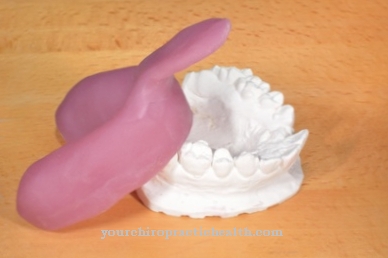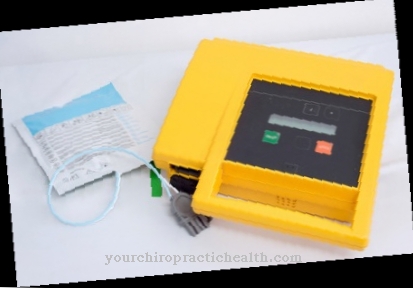Under Nasal patches are understood to mean special adhesive plasters that the user sticks to the bridge of his nose. They are designed to make breathing easier through the nose.
What are nose patches?

Nasal patches are also called Nose strips or Nasal strips known. This is a strip of adhesive plaster with broadly rounded ends. The nasal strip is attached to the bridge of the nose. The nasal patch has specially curved reinforcements made of plastic. These cause the nostrils to be pulled slightly upwards. With this effect, more efficient nasal breathing is possible. The nasal plaster is used for different purposes.
The development of the nasal patch took place in 1993 in the USA by the company "BreatheRight". The purpose of the special patch was to combat loud snoring. By lifting the nostrils, a better passage of air should be made possible. With the help of the patch, more air flows into the nose and makes breathing easier, which in turn has a positive effect on snoring. In addition to snoring, other obstructions to nasal breathing can also be treated with a nasal strip.
In Europe, the nasal patches became popular with football in the mid-1990s. The strips were also used in American football in the USA, which in turn caught the attention of football clubs. The nasal strips served to improve the supply of oxygen. After the European Football Championship in 1996, the nose patches found their way into the German Bundesliga and were also used in other sports.
However, whether they actually improved athletic performance remained controversial. Sports physicians advise trying out nasal patches and finding out for yourself whether they have a positive effect. Ultimately, this also depends on the causes of the obstructed nasal breathing.
Shapes, types & types
Originally, the nasal patches were designed to treat snoring during the night, because snoring mostly results from restricted nasal breathing. Sometimes colds or allergic reactions are also responsible for the swelling of the nasal mucous membranes. A crooked nasal septum can also cause snoring, as less air is inhaled through the nose in this case. In addition, the nasopharynx muscles in humans slacken during sleep, which in turn affects the supply of air to some extent.
In order to get more air, the person automatically opens their mouth, but this leads to the throat area drying out. The soft palate vibrates when breathing and leads to the typical sound of snoring. By using a nasal plaster against snoring, the mouth no longer opens so wide that the snoring noises are reduced or even disappear completely. The risk of sleep apnea is also reduced.
Nose patches are very popular in the sporting field. As a result of physical exertion, the nasal mucous membranes swell, which leads to less air passing through. With the help of a nasal patch, the amount of air inhaled should increase significantly. In addition, the nose strips have the advantage of not causing any annoying side effects.
Another variant of nasal patches is used to treat annoying blackheads on the nose. This can be done with a special Clear-up strip remove. Nasal plasters are particularly suitable for people who suffer from sensitive skin. With a blackhead plaster, the blackheads can be removed in just ten minutes and usually without pain. Pre-treatment is not required. However, there is a possibility that treatment with blackhead strips does not always bring the desired results. In addition, therapy with these special nasal patches is considered to be relatively expensive.
Structure & functionality
Nasal patches are available from pharmacies without a prescription. They are made up of two elastic strips of plastic that are embedded in the plaster. These plastic strips open the nostrils in a mechanical way. The strips are attached to the bridge of the nose with the adhesive plaster.
Medical ingredients are not contained in a nasal patch. As a result, there are hardly any disturbing side effects. In some cases slight local irritation from the patch may occur. Since there is no risk of interactions with medication, the nasal patches are suitable for joint use with other medication.
Using the nasal patch is simple. It is simply glued to the bridge of the nose. The nasal strip then causes the nostrils to lift, causing the nasal passages to widen. The air supply improves and the user finds restful sleep more easily.
You can find your medication here
➔ Medication for sleep disordersMedical & health benefits
According to studies, the use of nasal patches is said to improve the air supply by 31 percent. In addition, around 90 percent of all users in a clinical study who suffered from nighttime snoring reported improved sleep quality. There were also advantages in athletes because they felt more productive. For example, nasal patches are considered suitable for endurance training. However, they are said to be less useful for sporting competitions, since the human body is more stressed in actual competition than in training.
Basically, the use of nasal plasters has advantages and disadvantages. The strips have a quick effect if the nasal breathing is too weak, which is responsible for snoring. The application is also quick and easy. Because nasal patches are hardly noticeable, the user quickly gets used to them. In contrast to a nasal butterfly, however, the widening of the nostrils is less. If the user suffers from sensitive skin, this will be noticeable the next morning on the nose by a recognizable imprint of the nasal patch.
From a health point of view, nasal patches can also be used to treat allergic reactions, swollen nasal mucous membranes during pregnancy and a cold.




























